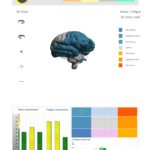We are used to facing stress in our everyday lives. However, the influence of the modern rhythm of life, bad habits and work can aggravate the body’s physiological response to stress. If you leave chronic stress uncontrolled, it can affect the emergence and development of various physical, behavioral and emotional disorders, such as diabetes, depression, migraine, hypertension, malignant neoplasms, gastric ulcer, heart disease, and many others.
Evaluation of health status and determination of the level of stress help determine the individual response of a person to stress and allow you to find a way to control it at the initial stages.
One of the main features of our systems is the assessment of stress and fatigue levels by analyzing the autonomic nervous system. This analysis gives an unbiased idea of the functional disorders of the body in response to stress and determines the following factors:
- Body imbalance triggered by accumulated stress
- Ability to self-regulate in stressful situations
- Ability to resist stress
The results of the examination are analyzed and recorded in a report, which in the future will allow the client to quickly and efficiently select the appropriate day regimen and the load level in order to successfully withstand stress.
Scientific methods to assess stress & fatigue levels
The autonomic nervous system is part of the entire nervous system of the human body. It plays an important role in maintaining homeostasis and an adequate course of adaptation processes of the organism. The work of the autonomic nervous system is in fact not controlled by the person.
The autonomic nervous system is divided into sympathetic and parasympathetic parts:
- Sympathetic system: by its activity we assess the level of stress – the system of “fight or flight”
- Parasympathetic system: by its activity we assess the level of fatigue – “rest and assimilation”
Heart rate variability
The heart rate variability analysis is a method of assessing the state of the mechanisms of regulation of physiological functions in humans and animals, in particular, the general activity of regulatory mechanisms, neurohumoral regulation of the heart, the relationship between the sympathetic and parasympathetic divisions of the autonomic nervous system.
Galvanic skin response
The galvanic skin response is a measure of the intensity of emotional arousal; it reflects the degree of the anxiety of a person. When a person works, he/she sweats, and this increases the skin electric conductivity.
Skin conductivity is not consciously controlled. Instead, it is modulated autonomously by sympathetic activity that governs the aspects of human behavior, as well as cognitive and emotional states. Consequently, skin conductance gives a direct idea of autonomous emotional regulation.
Read mode about our technology here.





